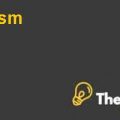
Henkel Iberica(A)
Introduction
Henkel isa pioneer company in automobile sector, which was founded in early 19th century.The company made a good brand name in the industry and then shifted towards the FMCG sector with the passage of time. In this sector, the company was growing at a fastpace and spread its operations toward the major region of Europe and then started operations in Latin America as well. The company also has a pioneer name in the present FMCG industry while having competition with giants in the industry but it keeps moving.
Problem Statement
Henkel Aberica was facing the threat of competition in the industry of FMCG especially in detergents division. Till the time the major market share of the industry was in the hands of giants like P&G Reckitt Benckiser and Henkel, the industry was facing a journey of smooth and significant growth however,when the needs of the consumers changed and the rivalry changed from innovation, quality and prestige to price,the intensityof rivalry continued to increasefor market share.Many private labels were formed and many other low quality and low price providerswere introduced in the industry.
The same problem went on with Henkel and it was unable to find the solution.Thisstudy will try to solve the question on how to overcome rivals and how to avoid the threats of loss.
Case Analysis
Implications in Functional Areas
Implications in manufacturing
As far as the data is concernedit is indicated that Montornes’ plan which is the biggest plant in the region produces 120,000 tons per year for detergents both liquid and powder. Moreover, the plant is capable to change the production lines as per the specifications of the demand, orders and promotional production if any.Also,it fulfills the need of 50 million consumers and produces almost 96 different SKUs for detergents.
As far as the data reveals that the plant changes almost 15 to 30 lines per month on average to produce promotional or any different style of SKUs when needed,this makesthe plant cost inefficient.This is because the plant is capital intensive and fully automated as whenever the lines changed the plant needs to be stopped and thissignificantly increases the manufacturing cost,which is quite high (see exhibit 2 in the excel sheet) when measured as a percentage of sales per Kg.
Distribution Implications
The distribution from warehouse to the retailer is quite inefficient since.There is no automated ordering system for retailer from where they can easily order the goods to the company. The current system takes one day for ordering and takes almost 1 to 4 days of lead time which is high enough and ultimately hits the company’s profit.
Procurement Implications
The purchasing of raw material and packing material is centralized, which is a good thing however,it needs more time for plants and warehouse to integrate with each other and letting the forward channel know that which thing is needed and which ultimately increases lead time. The plant takes 50 to 60 deliveries per day of raw and packing material as per the policy of JIT inventory per day from 120 suppliers, which is a good example of strategic relations however;it increases freight cost and lead time for raw material which ultimately leads to inefficiency and timely productions. Transportation and warehousing cost is quite high because of the lack of integration between manufacturing, distribution and procurement system (see exhibit 2 in excel sheet).........
This is just a sample partial case solution. Please place the order on the website to order your own originally done case solution.













